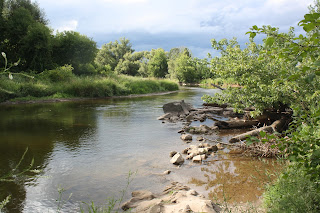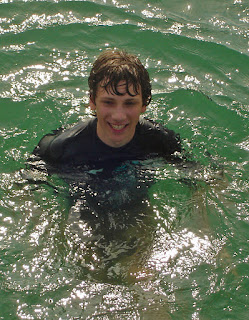 |
| scotch on the Faculty Club patio |
It’s been a while since
I drank scotch.
The last time was more
than several years ago in a dark bar at the foot of Mount Kilimanjaro in
Tanzania.
I had just come down the
mountain, having barely reached the upper foothills. My friend Margaret and I
had abandoned the taxing ascent in favor of a more pleasant and relaxing hike
and more time at the local bar. The place was somewhat run down and smelled of
burnt plantain and rotting fruit. All they had was scotch. The whisky burned
down my throat like a wild fire; its pungent rawness mocked the disappointment that
lurked beneath my relief in the abandoned climb. As I nursed my drink over some
fried goat’s meat, I decided that I didn’t like scotch. And that was that.
Scotch—like the peak of Kilimanjaro—remained elusive.
Many years later, I
found myself travelling in Kentucky and sampling its signature drink—Kentucky
small batch bourbon whisky. Bourbon is a barrel-aged American whiskey made
mainly of corn. Like Champagne, Bourbon is named for the area it was first
conceived, known as Old Bourbon (now Bourbon County in Kentucky)
and after the
French House of Bourbon royal family. The typical bourbon grain mixture, called
mash bill, is 70% corn mixed with wheat and/or rye and malted barley. Yeast is
added to a sour mash of ground grain and then fermented. This “wash” is then
distilled into a clear spirit, which is aged in charred white oak barrels.
Bourbon gains color and flavor from the wood as it ages. When I finally
graduated to drinking bourbon neat, I learned to look for a premium class
sipping whiskey that is a Kentucky Straight (aged at least two years and made
entirely in Kentucky) and a single-barreled bourbon (e.g., the bottle comes
from an individual aging barrel; not a blend from various different barrels to
provide uniformity of color and taste). A good sipping bourbon boasts a very
deep and satisfying nose, with a start of caramel and vanilla and a “soft
pepper” aftertaste.
 |
| Getting the Lagavulin, Faculty Club Pub |
Fast forward to a few
days ago, as I lounged in the outside patio of the University of Toronto
Faculty Club, recently opened for the season. It was early May and a warm
breeze brought with it the promise of adventure. The patio provided a cheerful
setting as I prepared to celebrate a double birthday—mine and a friend’s—as
well as my soon to be released book Water Is… I decided to order a
bourbon as I waited for my friend to arrive. Alas! They didn’t have any! What
was a girl to do for her birthday and first of many launch celebrations?
 |
| UofT Faculty Club patio |
“The 16-year old
Lagavulin is a lovely scotch,” offered one of the kind patrons as reprieve to
my forlorn disappointment. I forgave him for not knowing my legacy with scotch.
“Lagavulin is a fine Islay single malt scotch; great for a celebration,” he
insisted. Malt
scotch whisky is made by the pot still process using malted barley only. And the
name Lagavulin, I later found, means “hollow by the mill” (Laggan Mhouillin) in Gaelic.
I demurred at first.
 |
| Faculty Club pub |
Then, with thoughts of
an elusive mountain unclimbed, I agreed and watched Leanne, the manager of the
Faculty Club, pour me a dram of intense amber liquid. She left the bottle for
me to study and I read the strange description on the front label:
“Moss water, passing
over rocky falls, steeped in mountain air and moorland peat, distilled and
matured in oak casks exposed to the sea shape Lagavulin’s robust and smoky
character. Time, say the Islanders TAKES OUT THE FIRE but LEAVES IN THE
WARMTH.”
When my friend arrived,
we toasted each other’s birthdays and ordered something to go with the scotch.
Merridy ordered the warm mushroom salad and I went with the club’s signature
macaroni and cheese, baked with spinach and mushrooms. Exquisitely baked and
briefly braised on top, the mac and cheese was a divine mate to the 16-year old
scotch. A libiamo ne’lieti calici of sharp
and salty seashore tempered with the bursting melt of cheese and pasta. A comingling
in a lively Verdi duet. I sipped my scotch and dug through the crispy crust of
baked cheese pulling out gooey strings of cheddar, parmesan, mushrooms and
spinach.
Mac and cheese
originated in southern Italy in the 12oos. Liber de coquina, written by
someone
familiar with the Neapolitan court then under Charles II of Anjou (1248-1309)
contains a recipe called de lasanis, purported to be the first “macaroni
and cheese” recipe.
 |
| Leanne inhales the "nose" of Lagavulin |
Six hundred years later, John Jonston and Archibald Campbell built the
Lagavulin distillery—a whitewashed
jumble of buildings by the sea—in the village of Lagavulin on the rocky southern shore of the island of Islay, the
southernmost of the Inner Hebridean Islands off the west coast of Scotland. Amy
Zavatto of Serious Eats describes
Islay as a “wild and windswept corner of the world where sheep may well
outnumber people and waterproof shoes are your good friend.” Peat, she reminds
us, is decomposed organic matter—grass, heather, moss—that forms along the
coastal, boggy lands that make up much of Islay. Peat holds moisture and smokes
wonderfully when you burn it. And when this is used to truncate the germinating
of the little barley bits via heat it flavors the malted barley with a unique
perfume. This is called peating whisky.
Most of Scotland’s distillers no longer peat their whiskies (preferring oil
burners); but Islay still harvest and burn peat to make their whisky.
 |
| Still pots at Lagavulin |
The Master of Malt writes that Lagavulin
is “a much sought-after single malt with the massive peat-smoke that's typical
of southern Islay—but also offering richness and a dryness that turns it into a
truly interesting dram. The 16 year old has become a benchmark Islay dram from
the Lagavulin distillery.” This 16-year spirit has won many awards, including
the Whisky of the Year in 2013. Lagavulin is known for its use of slow
distillation speed and its pear-shaped pot stills.
The waters of Solum Lochs, along with the peating levels of the
barley, help give this scotch its distinctive flavor. In an interview with Eric
Knudsen, master distiller Donald Renwick of Lagavulin affirmed that, “The water from the Solum
Lochs is obviously important, as it is our own water, good quality with lots of
peat in it. However one of the most important parts is the Malted barley
(malted at our own Maltings plant on Islay) During the kilning process a peat
fire introduces the peat smoke into the malted barley. This gives Lagavulin its
distinctive peaty and smoky flavours.”
T
he Whisky Exchange writes that,
“Lagavulin is not for the faint-hearted but inspires fanatical devotion in its
many followers.” Says Zavatto: “Give it a couple of gentle sniffs (e.g., don't go
sticking your nose all the way in the glass; there's a lot of alcohol there, so
take it in easy!) to take in that first burst of sea spray and smoke, and then
try to see what else you find underneath that. I'd recommend that you consider
adding a drop or two of water, which you'll find really teases out some of the
underlying orchard fruit, citrusy, or caramel-vanilla notes that are lurking
beneath the peaty surface. This is, after all, uisge beatha—the water of
life. It's worth a wee moment or two to enjoy it.”
 |
| Lagavulin on Islay |
The whiskies of the nine or so distilleries along the southeastern coast
of Islay typically
express that smoky character and what some—me included—would
describe as a “medicinal” quality. Notes of iodine, seaweed and salt have been
used to describe the element that I found deliciously unidentifiable.
It made perfect sense, I finally decided, reminded of what D.H.
Lawrence said about water: “Water is H2O, hydrogen two parts, oxygen one; but
there is also a third thing that makes it water. And nobody knows what it is.”
So with water; so with scotch. Uisge
beatha.
The University of Toronto Faculty Club is located on 41 Willcocks
Street, Toronto, Ontario; 416-971-2062.
My book, “Water Is…” was released worldwide on May 10, 2016.
Water Is…
Pixl Press
ISBN: 978-0-9811012-4-8
 Nina Munteanu is an ecologist and internationally published author of award-nominated speculative novels, short stories and non-fiction. She is co-editor of Europa SF and currently teaches writing courses at George Brown College and the University of Toronto. Visit www.ninamunteanu.ca for the latest on her books. Nina’s recent book is the bilingual “La natura dell’acqua / The Way of Water” (Mincione Edizioni, Rome). Her latest “Water Is…” is currently an Amazon Bestseller and NY Times ‘year in reading’ choice of Margaret Atwood.
Nina Munteanu is an ecologist and internationally published author of award-nominated speculative novels, short stories and non-fiction. She is co-editor of Europa SF and currently teaches writing courses at George Brown College and the University of Toronto. Visit www.ninamunteanu.ca for the latest on her books. Nina’s recent book is the bilingual “La natura dell’acqua / The Way of Water” (Mincione Edizioni, Rome). Her latest “Water Is…” is currently an Amazon Bestseller and NY Times ‘year in reading’ choice of Margaret Atwood.
Pixl Press
ISBN: 978-0-9811012-4-8
 Nina Munteanu is an ecologist and internationally published author of award-nominated speculative novels, short stories and non-fiction. She is co-editor of Europa SF and currently teaches writing courses at George Brown College and the University of Toronto. Visit www.ninamunteanu.ca for the latest on her books. Nina’s recent book is the bilingual “La natura dell’acqua / The Way of Water” (Mincione Edizioni, Rome). Her latest “Water Is…” is currently an Amazon Bestseller and NY Times ‘year in reading’ choice of Margaret Atwood.
Nina Munteanu is an ecologist and internationally published author of award-nominated speculative novels, short stories and non-fiction. She is co-editor of Europa SF and currently teaches writing courses at George Brown College and the University of Toronto. Visit www.ninamunteanu.ca for the latest on her books. Nina’s recent book is the bilingual “La natura dell’acqua / The Way of Water” (Mincione Edizioni, Rome). Her latest “Water Is…” is currently an Amazon Bestseller and NY Times ‘year in reading’ choice of Margaret Atwood.















